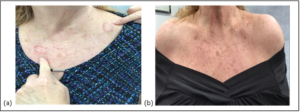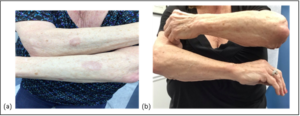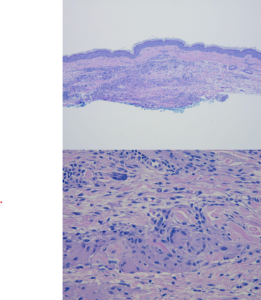Case Report | Vol. 5, Issue 2 | Journal of Clinical Medical Research | Open Access |
Successful Treatment of Granuloma Annulare with Tapinarof 1% Cream: A Case Report
Maria L Andrzejewski1







1Robinson and Max Dermatology PA, Lutherville-Timonium, Maryland, USA
*Correspondence author: Edward M Klepper, Robinson and Max Dermatology PA, Lutherville-Timonium, Maryland, USA; Email: [email protected]
Citation: Andrzejewski ML, et al. Successful Treatment of Granuloma Annulare with Tapinarof 1% Cream: A Case Report. Jour Clin Med Res. 2024;5(2):1-5.
Copyright© 2024 by Andrzejewski ML, et al. All rights reserved. This is an open access article distributed under the terms of the Creative Commons Attribution License, which permits unrestricted use, distribution, and reproduction in any medium, provided the original author and source are credited.
| Received 06 August, 2024 | Accepted 23 August, 2024 | Published 30 August, 2024 |
Abstract
Granuloma Annulare (GA) is an inflammatory, granulomatous skin condition that presents with erythematous plaques or papules with several subtypes including patch, perforating, subcutaneous and atypical. GA is benign and usually regresses on its own but tends to recur frequently. It can be treated topically for localized areas but there is little research-based evidence on proven efficacious therapies, making treatment decisions difficult. Here, we present a case of granuloma annulare that was successfully treated with Tapinarof 1% cream.
Keywords: Granuloma Annulare; Aryl-Hydrocarbon Receptor; AHR; Granulomatous Disease; Tapinarof; Tumor Necrosis Factor-Alpha Antagonists
Introduction
Granuloma Annulare (GA) is an inflammatory, granulomatous skin condition characterized by erythematous papules and plaques that can be localized, disseminated or photodistributed. The pathophysiology of the disease remains unknown. The condition is benign and often self-limiting, but it tends to recur which is why treatment is often initiated. There are many different treatment options, with systemic corticosteroids or intralesional steroid injections typically being first-line [1]. Other second line therapies have been topical calcineurin inhibitors, topical imiquimod cream, cryotherapy, narrow band UVB and other oral therapies including isotretinoin, methotrexate, dapsone, hydroxychloroquine and pentoxifylline1. There are few and far between double-blinded research trials to support these therapies in the management of GA. We present one of the first case reports revealing successful treatment of granuloma annulare with tapinarof 1% cream (Vtama).
Ethical Statement
The project did not meet the definition of human subject research under the purview of the IRB according to federal regulations and therefore, was exempt.
Case Report
A 71 year-old woman presented to our office as a new patient with a six-month history of erythematous papules scattered on her chest and forearms that were not amenable to topical steroids prescribed by her primary care physician. Exam revealed multiple red annular papules and plaques on her left anterior shoulder, upper chest and dorsal surfaces of both forearms (Fig. 1,2). The rest of the clinical exam was unremarkable and pertinent medical history included arthritis, diabetes mellitus, hypercholesterolemia, hypertension and history of sunburns.

Figure 1: (a): Pink annular plaques on the upper chest and left anterior shoulder; (b): Resolution of lesions after one month of Tapinarof use.

Figure 2: (a): Pink annular plaques on bilateral dorsal forearms; (b): Resolution of lesions after one month of use with Tapinarof.
A shave biopsy was obtained from her left anterior shoulder and sent out to pathology. The differential included granuloma annulare, actinic granuloma and annular elastolytic giant cell granuloma. The pathology report revealed histiocytes aggregating around collagen bundles of the reticular dermis with palisaded zones of basophilic collagen and increased deposition of mucin. Also, there were scattered areas of phagocytosis of elastic fibers. In addition, there was a perivascular lymphocytic infiltrate. Also neutrophils are focally involving the lumen of an eccrine duct. These findings are consistent with the diagnosis of granuloma annulare, however, similar findings can be seen in annular elastolytic giant cell granuloma (Fig. 3).

Figure 3: 40x, 200x magnification. Palisaded interstitial histiocytic infiltrate with some multinucleated giant cells demonstrating elastophagocytosis, accompanied by a mild perivascular lymphocytic infiltrate.
The patient’s treatment course was initially started with Clobetasol 0.05% ointment to be applied topically twice daily for two weeks and then twice a week until her follow-up in one month. At the time of her follow-up, the patient reported no improvement and thus it was recommended to try occlusion of the lesions with saran and Clobetasol 0.05% ointment until her next follow-up.
These treatments did not prove to be effective, so intralesional steroid injections with Kenalog 5 mg were tried but no improvements were seen. The same went for roflumilast 0.3% (Zoryve) cream that was prescribed after the intralesional steroid trial. Finally, tapinarof 1% cream was prescribed to the patient to be applied once daily to the lesions. One month after this initiation, the patient presented to our office with resolution of the lesions on her dorsal forearms and upper chest (Fig. 1,2). The medication was well-tolerated by the patient and she reported no adverse effects.
Discussion
The pathogenesis of GA is unknown. Some research has indicated that solar radiation causes degeneration of tissue in the upper dermis which triggers an autoimmune cell-mediated response by CD3+ and CD4+ cells; when they repair the damage it leads to granulomatous inflammation [1,2]. This inflammation is most often observed in the sun-exposed areas of the skin such as the face, chest, extensor surfaces and dorsums of the hands. Some studies have also suggested that GA could be caused by T-helper-1 reactions triggering the release of matrix metalloproteinases by IFN-gamma stimulating macrophages, while others showed that some patients with GA have impaired neutrophil chemotaxis [1].
Annular Elastolytic Giant Cell Granuloma (AEGCG) and Actinic Granuloma (AG) favor sun-exposed areas and appear similar to GA. They are difficult to distinguish clinically and histologically [3,4]. The photodistribution of the lesions in this case report suggested AEGCG or AG. Among other histologic characteristics, our case had mucin present which is not typically present in AEGCG or AG and is more characteristic of GA [3,4]. These authors believe that AEGCG and AG are not independent conditions but variants of granuloma annulare [5].
GA can spontaneously regress but in most cases lesions will reoccur and thus treatment may be indicated. Intralesional steroid injections or systemic corticosteroids are the first-line therapy for GA but other treatments such as phototherapy, hydroxychloroquine, dapsone, retinoids and tumor necrosis factor-alpha inhibitors have been shown to be effective in small studies [1].
In this case, our patient had tried multiple trials of clobetasol, intralesional steroid injections and roflumilast 0.3% cream without resolution of symptoms. Her most recent trial of medication was with tapinarof 1% cream and this medication resolved the majority of her lesions within one month. The usual dosage of tapinarof is a topical application once daily but these authors decided to change the frequency to twice daily to increase absorption.
Tapinarof is an Aryl hydrocarbon Receptor (AhR) agonist that is FDA approved to treat plaque psoriasis. AhR works by suppressing Th17 cell differentiation and the production of IL-17 and IL-22, while also restoring the skin barrier by upregulating skin barrier proteins. The medication works by binding to AhR and activating it, which causes the downregulation of inflammatory cytokines [5]. Specifically, it is found to downregulate TNF-α, IL-23 and IL-176. It is also found to inhibit the activation of STAT6, through the inhibition of IL-4 and IL-136. For this reason, the Anti-TNF and JAK-inhibitor properties of Tapinarof have been seen to benefit those with necrobiosis lipoidica [5]. This is significant because necrobiosis lipoidica is a granulomatous skin condition, like granuloma annulare and both of these conditions can be characterized histologically by areas of necrobiosis of collagen.
Conclusion
We recognize the occurrence of GA can regress with time alone, however, most cases recur and raise cosmetic concerns and discomfort to the patient. There are multiple pathogenic theories but none have proven to be definitive. Tapinarof has been shown to suppress inflammation through downregulation of inflammatory cytokines such as IL- 17, IL- 23 and also IL4 and IL-13 mediated inactivation of STAT 6 protein which is a precursor to various inflammatory pathways. We believe that Tapinarof may be working on one of these pathways triggering GA and thus larger trials with this novel agent and patients with GA should be studied to understand the efficacy.
Conflict of Interests
The authors declare no conflict of interest regarding authorship roles or publication of article.
Consent
Verbal consent for publication of their details was obtained from the patient.
Disclosure
The authors report no conflicts of interest.
Acknowledgement
We would like to acknowledge Dr Max Fischer from Bethesda Dermatopathology Laboratory for providing the photomicrographs.
Financial Disclosure
No funding was not involved in the manuscript writing, editing, approval or decision to publish.
Authors Contribution
All the authors have equal contribution and all the authors have read and agreed to the published version of the manuscript.
Authors Contribution
All the authors have equal contribution and all the authors have read and agreed to the published version of the manuscript.
References
- Schmieder SJ, Harper CD, Schmieder GJ. Granuloma annulare. Treasure Island (FL): StatPearls Publishing. 2024.
- Mistry AM, Patel R, Mistry M, Menon V. Annular elastolytic giant cell granuloma. Cureus. 2020;12(11):e11456
- Promsena P, Triyangkulsri K, Rutnin S. Two case reports of elastolytic giant cell granuloma on the palms. Clin Cosmet Investig Dermatol. 2023;16:2497-502.
- Ragaz A, Ackerman AB. Is actinic granuloma a specific condition? Am J Dermatopathol. 1979;1(1):43-50.
- Palomares SJ, Farberg AS. Nonulcerated necrobiosis lipoidica successfully treated with tapinarof: a case report. Clin Cosmet Investig Dermatol. 2023;16:1373-6.
Author Info
Maria L Andrzejewski1







1Robinson and Max Dermatology PA, Lutherville-Timonium, Maryland, USA
*Correspondence author: Edward M Klepper, Robinson and Max Dermatology PA, Lutherville-Timonium, Maryland, USA; Email: [email protected]
Copyright
Maria L Andrzejewski1







1Robinson and Max Dermatology PA, Lutherville-Timonium, Maryland, USA
*Correspondence author: Edward M Klepper, Robinson and Max Dermatology PA, Lutherville-Timonium, Maryland, USA; Email: [email protected]
Copyright© 2024 by Andrzejewski ML, et al. All rights reserved. This is an open access article distributed under the terms of the Creative Commons Attribution License, which permits unrestricted use, distribution, and reproduction in any medium, provided the original author and source are credited.
Citation
Citation: Andrzejewski ML, et al. Successful Treatment of Granuloma Annulare with Tapinarof 1% Cream: A Case Report. Jour Clin Med Res. 2024;5(2):1-5.



